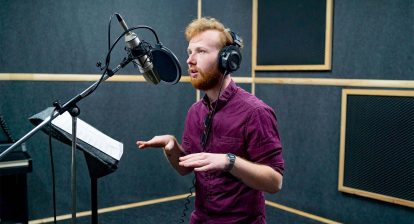 Translation
Translation
How to Add Voice to Video: Dubbing
Looking for tips on how to add voice over to your video? Our in-house audio producer Randy created this video that explains how to get the job done.
If you’re looking to add another language of voice over to your video to translate it for a new audience, then you’re looking to “dub” your video. Rest assured, the tips Randy provided in the video still apply to dubbing, especially when playing with the pacing of the voice over.
Learn how to add voice over to a video, dubbing it into another language and find out how dubbing is quickly becoming a mainstream media trend.
How to Add Voice to Video: Dubbing
Dubbing removes the video’s original spoken audio track and replaces it with a new one in another language, while retaining the same tone as the original. This process is also known as ‘revoicing.’
A few cautions to be aware of, that with good planning, can be mitigated:
- A badly dubbed video can end up looking like a parodic version of the original, and if you aren’t looking for that quality then it’s really important to pay close attention to the entire process.
- Additionally, while dubbing is worth it to bring your videos to new audiences, it can prove to be quite a time-consuming and costly process, so any mistakes will surely increase your overhead costs.
- Most importantly, your video’s new audio should be recorded by a professional dubbing voice actor who can deliver the same rhythm and timing of the original audio, to ensure that it seamlessly syncs with the video footage while delivering similar messaging.
Before you get started, here are the things you will require:
- Original character sketch: This will help you understand the original characters’ personalities.
- Original cast information: To help you analyze the original voice(s) and understand why they resonated with the initial audience.
- Original script and dialogue list: To translate the script into the specified language.
- Audio and video files from the original work.
- Technical equipment: Recording booth and editing software for audio dialogue replacement (ADR).
How to Add New Voice Over to Video
1. Translate or Localize Your Original Script
2. Voice Cast for the Dubbing Project
3. Record the Translated Script
4. Sync the Dubbed Audio
1. Translate or Localize Your Original Script
The first step in dubbing is translating or localizing your original script into the specified language by understanding the original character(s), dialogues and tone of the video. Keep in mind that localization isn’t the same as simple translation. Instead, it’s all about using the audience’s local language or dialect to strike a connection with them, similar to what your original content does.
Note: Read about the difference between translation and localization.
Translating the script can be a challenge as critical parts like humor and cultural references can get lost in the process. That’s why it’s worth it to invest in localization, which adapts the messaging to the culture and language of the audience, rather than a direct, word-for-word translation.
If you’re re-creating the script yourself, feel free to rewrite certain parts to suit the target audience, as this will make the dubbing more authentic and appealing to audiences. Rewriting allows you to add culture specific elements into the script, building relatability with your audience because of the familiar elements.
For example, the highly successful Japanese cartoon, Doraemon airs in several countries, in a variety of languages like Hindi and Mandarin, and the creators and distributors have gone the extra mile to make the series a worldwide phenomenon. This includes making the cartoon more culturally appealing to young viewers from other cultures, by renaming Japanese terms like ‘dorayaki,’ into more simpler terms like ‘dora cakes.’ Dora cakes have become a huge part of Doraemon’s fandom, with people regularly searching for the treat and its recipe, showing how smart dubbing ensures great commercial success.
Scholarly analysis of what makes for a successful localized film, has found that a good translator should focus on recreating linguistic relations that can generate specific feelings and reactions from the audience. For example, if a certain portion of the film is intended to lift the audiences’ hope in the hero succeeding, then the dialogue should be modified to convey that emotional trajectory.
Another crucial task involved in the rewriting process involves the ‘lip-sync.’ This means the new script must mimic the same number of syllables/words in the lines, so that the new audio matches the character’s mouth movements.
Entertainment One released an animated series on YouTube and other digital streaming platforms for the Hasbro Baby Alive Dolls. The lip-syncing achieved in the dubbing plays a pivotal role in the success of the show with over 100 million views of play time within the first 4 months of release! Read about how Entertainment One found their localization-dubbing talent on Voices.
2. Voice Cast for the Dubbing Project
Next, you’ll want to ensure you are casting a voice actor who knows the cultural nuances of the language or dialect, and can express the exact voice qualities the role requires.
To ensure that the best voice actors audition for your project, write a strong job description which specifies the language, dialect and voice qualities you are looking for. This helps a voice actor understand the role better and reduces the chances of miscommunication during the project.
3. Record the Translated Script
The voice actor will now record the new audio for your video, ensuring that the performance matches the quality of the original.
While directing the project, you have to determine if the translated script sounds convincing. Essentially, the translated script should sound authentic and not forced or unnatural.
Voice actor Tara Sands has been a part of many translated Japanese video games. In her experience, a crucial part of dubbing is to ensure that the timing and tone matches the original work.
“They like to bring in people who can listen to the original Japanese and match it for time and tone. They often don’t want an exact voice match, but you still have to honor the spirit of the original voice,” explains Sands.
As Sands explains, you don’t need to make the voice actor mimic each and every sound the original audio contains. Sometimes, translations can slightly shift the meaning of a scene, and sounds like laughs or smirks, should only be included if they add meaning to the situation.
4. Sync the Dubbed Audio
Syncing the dubbed audio file with the video is a highly technical task because it involves making sure the voice over syncs with the original character’s mouth movements.
You will need to assemble, synchronize and edit the audio to match it with the video file in a process called Audio Dialogue Replacement (ADR).
Accurate syncing ensures audiences don’t see a character’s mouth open during the absence of dialogue.
Remember to hear the whole audio and take out any superfluous words to make the video more interesting. The whole process is highly time consuming, but the effort and time will pay off when you see the end product. You can also hire an ADR technician for a more accurate result, especially if you’re not a very experienced video editor.
The Trend of Dubbing for International Markets in 2022
The art of dubbing has definitely improved within the last few decades, consequently increasing its demand around the world.
The circulation of media is no longer restricted by the barriers of language, as we see hundreds of films and television shows being translated into multiple languages and dialects around the world. You can easily watch a Japanese or French film in your native language by looking for the dubbed version.
Consider how Netflix has created a global empire by localizing their content on a country-by-country basis and then dubbing it for that region of the world.
The Popularity of Fandubs
In the late ‘90s, anime swept audiences in America with shows like Sailor Moon enchanting viewers and introducing them to Japan’s amazing anime culture.
Initially, people were not happy with how the dubbing removed cultural references from the script, but now dubbing processes have evolved and become more faithful to the source materials, showing how translators are taking the art of dubbing more seriously.
The history of anime localization continues to move forward. The love for anime dubs is reaching new heights, with the rise of ‘fandubs,’ which are essentially anime shows dubbed by fans who strive to improve the already translated versions, or alter the show’s plot. An example of this would be Team Four Star’s abridged version of Dragon Ball Z, a very popular version of the famous anime show.
Studio Ghibli’s GKids YouTube channel features trailers of dubbed Japanese anime films, catering to thousands of devoted fans who wait eagerly for such releases. Studio Ghibli’s films are successful outside of Japan because the dubbing projects involve directors and talented voice actors who understand the challenges of translating well-loved films.
The English language trailer for Okko’s Inn shows how a properly dubbed film can create the same magic of the original, and excite viewers around the world. Madigan Kacmar, a young voice actor, beautifully brings the translation to life by capturing the personality of the young Japanese protagonist, Okko.
When an audience positively receives your dubbed version, you realize that all your hard work eventually pays off. The world is transforming into a global village and the demand for dubbing will only increase, giving you many opportunities to create translated and localized content.
Are you looking for a talented voice actor for your new dubbing project? Sign up to post a job and receive responses for free to see the localized script translations and auditions that could be used for your project!
Post originally authored by David Ciccarelli in October 2020.



Comments
When Lubna writes: “editing software for audio dialogue replacement (ADR)”
what does she specifically mean? I have Adobe Audition CC 2017 upgraded to 2020. Do I have to have ProTools to do ADR? Adobe Premiere Pro be sufficient? Thank you.
Hi Adam,
At the very least, you’ll need to have audio recording software (Adobe Audition will do!). However, you will also want to have software that allows you to edit/align video and audio files together so that you can replace the dialogue in the video in question (Premiere would be great!). Good luck!
Help me to find an app where I can do voice over scripts before I start working. I am interested in voices.com
Like my practice demo account
Hey Mayibongwe,
If you’re looking for somewhere to start, you can browse our selection of sample scripts and record yourself performing the ones you like the most: https://www.voices.com/blog/voice-over-sample-scripts/
Happy recording,
Oliver
I intrested & trust voices .com
All well